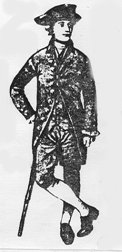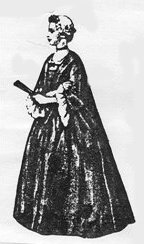William(1) Newman - c.1687 - 1762
Elizabeth Newman - 1695 - 1769
William and Elizabeth are my five times great-grandparents.
William(1) is the earliest of my known Newman ancestors. William
and Elizabeth were alive in the time of Queen Anne who reigned
from 1702-1714. They were certainly alive when George I was
brought from Hanover, Germany to become king of England in 1714.
They lived through the reign of George II and some of the reign
of George III.
Elizabeth Elver was married first to Nicholas BROCKENBROW. (In
the Wiltshire marriage index, 1700-1739 there is this
information:- Nicholas Brockenbrow Gent. of Grittleton Wilts m
Elizabeth ELVER age 20 of Castle Combe Wilts. on August 28 1714
at Castle Combe. Witness John Forman, Publican from Devizes.)
They had three children, all baptised in Castle Combe - Anne,
baptised on 30th June 1715 (born 27th June) buried 7th December
1715; Elver, baptised 12th September 1716, buried 20th November
1749 and Nicholas, baptised 2nd August 1718 and buried 18th
August 1718. Elizabeth's husband, Nicholas died and was
buried on 22nd March 1717/8. It would seem to have been a short
and sad marriage with the deaths of two babies and her husband.
Her son, Elver Brockenbrow died in 1749 at the age of 33.
I cannot find the marriage of William (1) Newman and Elizabeth
Brockenbrow in the parish records however, feel fairly confident
she was Elizabeth Brockenbrow, née was ELVER. The evidence I
have for this is that (1) there is a will of a man in Castle
Combe that was signed by William & Elizabeth Newman and an Ann
Elver (from her age at death in the parish records it would seem
likely that Ann Elver was Elizabeth's mother. She was living
with them at the time); (2) an inn called "The George" in Castle
Combe which once belonged to Nicholas Elver and later to Thomas
Elver eventually was left in Elizabeth's will to her son William
Newman; (3) Thomas Elver (d. 1693) had an only child, a daughter
Elizabeth whose date of birth, 15th August 1695, fits nicely with
Elizabeth Newman; (4) William and Elizabeth's grandson was called
"Elver" and he carried on the Elver name by naming his first
daughter Ann Elver (probably after her great-grandmother). The
name of Elver was carried on in the Newman family for three more
generations as a forename.
Another piece of evidence is some signatures of Elizabeth's that
I have. One is on the inventory of Nicholas Brockenbrow's goods as
Elizabeth Brockenbrow and two others as Elizabeth Newman on two
wills. They certainly seem to have been written by the same hand.
Also on one of the wills she signed is also the signature (or
sign) of her mother, Ann Elver. Later there is her own will and
although she has shortened her forename to Eliza and it shows
signs of age, it is still clearly the writing of the same person.

I assume that ELIZABETH BROCKENBROW, née ELVER married WILLIAM
NEWMAN(1), my five times great-grandfather sometime about 1720.
On William (1)'s grave there is the word Gent. (meaning
gentleman) after his name so I think that these pictures give a
good idea of how William (1) and Elizabeth may have been dressed.
 |
 |
During the lives of William and Elizabeth, Castle Combe was a
busy market town. It was also the centre of a thriving woollen
industry. Sheep were grazed on the fields, shorn and their wool
spun and woven in cottages - the women spinning and the men
weaving. The cloth was beaten in mills run by the fast flowing
Bybrook and stretched on tenter hooks in the surrounding fields.
William and Elizabeth do not seem to have been directly involved
in this industry although Elizabeth certainly owned land on which
sheep were probably grazed. The wealth of the millers probably
helped the prosperity of the George Inn which may have been the
home of William and Elizabeth.
Sir Robert Walpole became the first British Prime Minister during
the lives of William (1) and Elizabeth. John Wesley was preaching
throughout England at that time too. Three great composers,
Handel, Bach and Mozart were making their music. Sir Joshua
Reynolds was painting his portraits. Edward Jenner was about to
begin his first vaccination experiments. Captain Cook was already
on the high seas but had not yet discovered Australia.
There were wars going on too. The War of the Spanish
Succession, 1701-1714, somehow involved most of Europe. In 1744
War broke out between France and Britain in Europe, India,
North America and the West Indies and lasted intermittently
until 1815. In 1703 Peter the Great founded St Petersburg. 1707
was the year of the Union of England and Scotland and the
combining of the Cross of St George with the Cross of St Andrew
to make the flag we know as the Union Jack.
I wonder how much of all these happenings William (i) and
Elizabeth were aware of.
William Newman is the furthest back Newman ancestor I have found
in Castle Combe. I do not know very much about him as so far I
have found very little documentation. Almost all I know is from
his will. He died in 1762. His tombstone in the churchyard at
Castle Combe is badly worn and I cannot make out any more than
his name with the word Gent. after it and the year of his death.
The parish records say that he was buried on 19th July 1762. I
do not know how old he was when he died so I cannot tell when he
was born. I have been unable to find his birth in any Parish
Records so far but I am still searching.
His will, which is dated 1759, is a very simple one in which he
leaves £5 each to his daughter, Elizabeth, and her children,
William and Jane. He leaves another £5 each to his daughter,
Ann, and son-in-law, Thomas Baker, and their children, Elizabeth
and Anne. To his son William (2) he also leaves £5 who at that
time was not married. He left £1 to his servant and £2 to the
poor which was to be given as bread. His beloved wife Elizabeth
was to be his Executrix.
Elizabeth's will, made in 1766, was a much longer and more
complicated one than her husband's. She also seems to have had
much more money and property to leave. I find this intriguing as
at this time everything that belonged to a woman became her
husband's property when she married (even her clothes). The only
way this could be prevented was if her property was tied up by
her father so that her husband could not touch it. Perhaps this
was done here.
 |
 |
|
The George Inn, owned by Nicholas Elver |
The initials of Nicholas Elver above the door.
|
|
|
Elizabeth left a property consisting of a house and land in
Nettleton (a nearby village) with a lease of ninety years to be
held in trust for her granddaughters, Elizabeth and Ann Baker,
until they were twenty-one. They were to have the income from
it before that. The trustees of the property, the Rev. Daniel
Mills and James Wild, were to receive £40 . She left to her
son, William (2), the leasehold on land called Woodbury Hill
with its barn and other buildings which was then being occupied
by her son-in-law John Coleman and daughter Ann. She also left
to her son, William (2), The George Inn and The Davenants with
all their `closes' and several parcels of arable and pasture land
which she had bought from the Lady of the Manor on leases of four
score and nineteen years from the date 1763. She then went on
to leave her daughter, Anne Coleman, the sum of £5 and the same
to Anne's husband, John Coleman (although this was not to absolve
him from his debt to her estate of £100). Her grandchildren,
Elizabeth and Ann Baker, were given another £4, her daughter,
Elizabeth Cambridge was left £20, and her grandchildren William
and Jane Cambridge were left £4 each, her daughter-in-law, Ann,
William's wife, was left another £4 and to Ann and William's
children, John William and Mary Newman, she left the sum of £40
although as it is very difficult to read at this stage and I cannot
be sure about this. Her son, William (2), also was left all her
furniture whether fixed to the dwelling house or not. This house
seems to be The George. She then bequeaths the sum of £3 to be
laid out in bread and distributed at the discretion of her
executors to the poor. She added a codicil to the will in
which she left to her son, William, for his use and enjoyment
what appears to be her "ssurnace and gnoshing Tub" as well as
all her goods and chattels.
Elizabeth Newman died in 1769 and was buried in Castle Combe
churchyard with her husband on 31st December of that year.
Unfortunately her age is not clear on the tomb.

The gravestones of William Newman (1) & Elizabeth, née Elver
William Newman (2) & Ann Jenkins and Elver Newman &
Ann, née Coleman.
|
Home
Back
|






